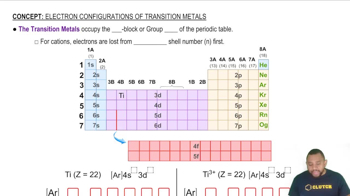Consider the reaction shown here occurring at 25°C. Cr(s) + Cd2+(aq) → Cr2+(aq) + Cd(s) Determine E°cell, K, and ∆G°rxn for the reaction and complete the table.
[Cd2+] [Cr2+] Q Ecell 𝚫Grxn
1.00 1.00
1.00 1.00 × 10-5
1.00 × 10-5 1.00
4.18 × 10-4 1.00
 Verified step by step guidance
Verified step by step guidance



Consider the reaction shown here occurring at 25°C. Cr(s) + Cd2+(aq) → Cr2+(aq) + Cd(s) Determine E°cell, K, and ∆G°rxn for the reaction and complete the table.
[Cd2+] [Cr2+] Q Ecell 𝚫Grxn
1.00 1.00
1.00 1.00 × 10-5
1.00 × 10-5 1.00
4.18 × 10-4 1.00
Consider the unbalanced redox reaction: Cr2O72-(aq) + Cu(s) → Cr3+(aq) + Cu2+(aq) Balance the equation and determine the volume of a 0.850 M K2Cr2O7 solution required to completely react with 5.25 g of Cu.
Determine whether HI can dissolve each metal sample. If it can, write a balanced chemical reaction showing how the metal dissolves in HI and determine the minimum volume of 3.5 M HI required to completely dissolve the sample. b. 4.85 g Cu
Determine whether HI can dissolve each metal sample. If it can, write a balanced chemical reaction showing how the metal dissolves in HI and determine the minimum volume of 3.5 M HI required to completely dissolve the sample. c. 2.42 g Ag
Determine if HNO3 can dissolve each metal sample. If it can, write a balanced chemical reaction showing how the metal dissolves in HNO3 and determine the minimum volume of 6.0 M HNO3 required to completely dissolve the sample. a. 5.90 g Au b. 2.55 g Cu c. 4.83 g Sn